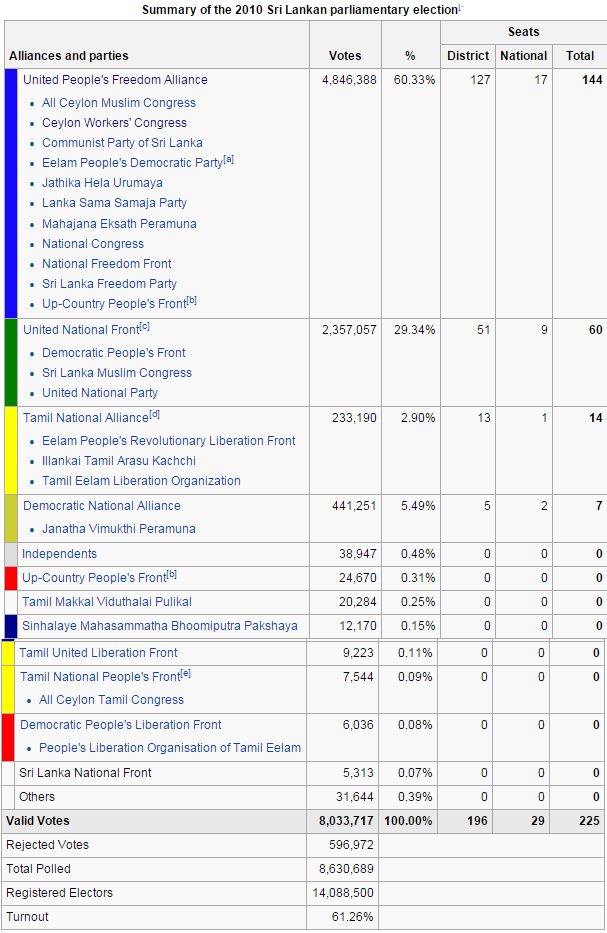Parliament-Poll 2010
Summary
The 2010 Sri Lankan parliamentary election was held on April 8 and April 20, 2010, to elect 225 members to Sri Lanka’s 14th Parliament. 14,088,500 Sri Lankans were eligible to vote in the election at 11,102 polling stations. It was the first general election held in Sri Lanka following the conclusion of the 30-year-long civil war.
The main parties contesting in the election were the party of Sri Lankan president Mahinda Rajapakse, the ruling United People’s Freedom Alliance (UPFA), the main opposition United National Front (UNF) and the Democratic National Alliance (DNA) of Sarath Fonseka. President Rajapakse was previously reelected as president in January 2010.
As expected, the UPFA secured a landslide victory in the elections, buoyed by its achievement of ending the 30 year Sri Lankan Civil War by defeating the Liberation Tigers of Tamil Eelam in May 2009. The UPFA won a large majority in the house, obtaining 144 seats, an increase of 39 since the 2004 election. The main opposition UNF is won 60 seats, a decline of 22. The minority Tamil party Tamil National Alliance (TNA) won 14 seats, down from the 22 they won in 2004, and the DNA, contesting for the first time, won 7 seats.The UPFA however fell short of its goal of obtaining a two-thirds supermajority in the house, which it would have needed to change the constitution on its own. The election saw the lowest voter turnout since independence.
While the election was initially scheduled to be concluded on April 8, irregularities in two districts led the Commissioner of Elections to hold re-polls on April 20. Final results were announced on the 21st, a day before the new parliament is scheduled to meet for the very first time.
Details
With the term of the 13th Parliament (also known as the 6th Parliament) scheduled to end in April 2010, Rajapaksa dissolved parliament on February 9, 2010, paving the way for fresh elections. Nominations took place between February 19 and February 26, and the date of the election was set for April 8, 2010. 14,088,500 Sri Lankans were eligible to vote in the election, for which 11,102 polling stations were set up. Of this, 415,432 people were eligible to cast their vote via postal voting. Final votes were counted at 1,387 counting centers around the country.
Since the 2004 election, there were four changes to number of seats allocated to each electoral district. Anuradhapura and Gampaha gained one seat each while Colombo and Kurunegala lost a seat each.
Contesting parties
- All the constituent parties of the ruling UPFA contested under its banner.
- The parliamentary opposition parties (UNF, Janatha Vimukthi Peramuna (JVP) and (TNA), who had come together to support common opposition candidate Sarath Fonseka at the presidential election, were unable to form a common alliance to contest in the election.
- UNF and the TNA contested alone, while Fonseka and the JVP allied to form a new alliance called the Democratic National Alliance (DNA). Fonseka was the DNA’s chief candidate in Colombo district.
- The UPFA, UNF and DNA contested in all 22 electoral districts while the TNA contested in the 5 districts in the north and east.
- The UNF contested under the name and symbol of the United National Party, as it had done in the previous two parliamentary elections. The TNA contested under the name and symbol of the Illankai Tamil Arasu Kachchi, as it did in the last parliamentary election.
- A record 7,680 candidates contested for the 196 district seats.
Results
Districts

Overall

References
Sri Lankan parliament election, 2010, en.wikipedia.org.
Archives
- May 2025 (6)
- November 2024 (4)
- August 2015 (5)
- July 2015 (1)
Latest Posts
- District-wise Seat Allocation Calculation (LG Election-2025) May 28, 2025
- Voter Turnout Across Recent Elections (2024-2025) May 26, 2025
- District-Wise Dominant Parties of LG Election 2025 May 19, 2025
- Local Government Election 2025 All Island Final Results May 8, 2025
- LG Election Results 2025 – RPO Areas May 7, 2025